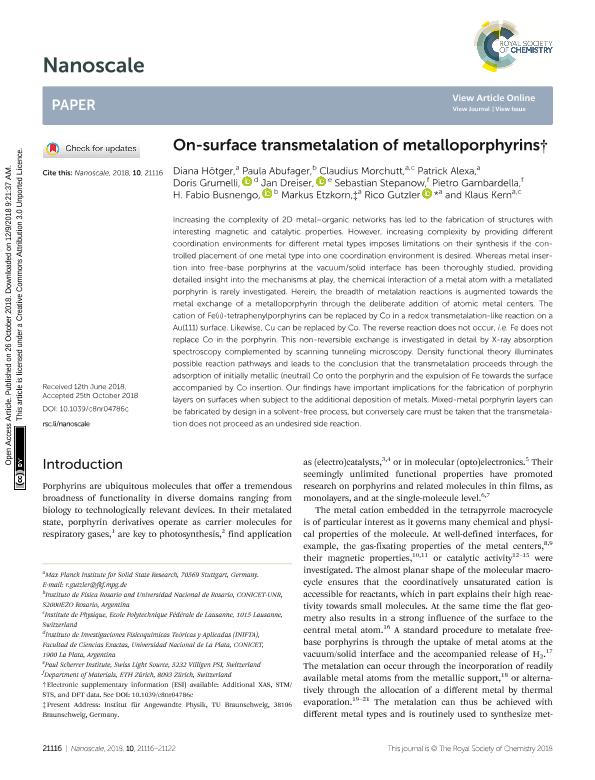Mostrar el registro sencillo del ítem
dc.contributor.author
Hötger, Diana
dc.contributor.author
Abufager, Paula Natalia

dc.contributor.author
Morchutt, Claudius
dc.contributor.author
Alexa, Patrick
dc.contributor.author
Grumelli, Doris Elda

dc.contributor.author
Dreiser, Jan
dc.contributor.author
Stepanow, Sebastian
dc.contributor.author
Gambardella, Pietro
dc.contributor.author
Busnengo, Heriberto Fabio

dc.contributor.author
Etzkorn, Markus
dc.contributor.author
Gutzler, Rico
dc.contributor.author
Kern, Klaus
dc.date.available
2019-11-12T12:18:27Z
dc.date.issued
2018-12
dc.identifier.citation
Hötger, Diana; Abufager, Paula Natalia; Morchutt, Claudius; Alexa, Patrick; Grumelli, Doris Elda; et al.; On-surface transmetalation of metalloporphyrins; Royal Society of Chemistry; Nanoscale; 10; 45; 12-2018; 21116-21122
dc.identifier.issn
2040-3364
dc.identifier.uri
http://hdl.handle.net/11336/88569
dc.description.abstract
Increasing the complexity of 2D metal-organic networks has led to the fabrication of structures with interesting magnetic and catalytic properties. However, increasing complexity by providing different coordination environments for different metal types imposes limitations on their synthesis if the controlled placement of one metal type into one coordination environment is desired. Whereas metal insertion into free-base porphyrins at the vacuum/solid interface has been thoroughly studied, providing detailed insight into the mechanisms at play, the chemical interaction of a metal atom with a metallated porphyrin is rarely investigated. Herein, the breadth of metalation reactions is augmented towards the metal exchange of a metalloporphyrin through the deliberate addition of atomic metal centers. The cation of Fe(ii)-tetraphenylporphyrins can be replaced by Co in a redox transmetalation-like reaction on a Au(111) surface. Likewise, Cu can be replaced by Co. The reverse reaction does not occur, i.e. Fe does not replace Co in the porphyrin. This non-reversible exchange is investigated in detail by X-ray absorption spectroscopy complemented by scanning tunneling microscopy. Density functional theory illuminates possible reaction pathways and leads to the conclusion that the transmetalation proceeds through the adsorption of initially metallic (neutral) Co onto the porphyrin and the expulsion of Fe towards the surface accompanied by Co insertion. Our findings have important implications for the fabrication of porphyrin layers on surfaces when subject to the additional deposition of metals. Mixed-metal porphyrin layers can be fabricated by design in a solvent-free process, but conversely care must be taken that the transmetalation does not proceed as an undesired side reaction.
dc.format
application/pdf
dc.language.iso
eng
dc.publisher
Royal Society of Chemistry

dc.rights
info:eu-repo/semantics/openAccess
dc.rights.uri
https://creativecommons.org/licenses/by/2.5/ar/
dc.subject
Porfirinas
dc.subject
Transmetalación
dc.subject
DFT
dc.subject.classification
Física Atómica, Molecular y Química

dc.subject.classification
Ciencias Físicas

dc.subject.classification
CIENCIAS NATURALES Y EXACTAS

dc.title
On-surface transmetalation of metalloporphyrins
dc.type
info:eu-repo/semantics/article
dc.type
info:ar-repo/semantics/artículo
dc.type
info:eu-repo/semantics/publishedVersion
dc.date.updated
2019-10-24T14:54:16Z
dc.journal.volume
10
dc.journal.number
45
dc.journal.pagination
21116-21122
dc.journal.pais
Reino Unido

dc.description.fil
Fil: Hötger, Diana. Max Planck Institute for Solid State Research; Alemania
dc.description.fil
Fil: Abufager, Paula Natalia. Consejo Nacional de Investigaciones Científicas y Técnicas. Centro Científico Tecnológico Conicet - Rosario. Instituto de Física de Rosario. Universidad Nacional de Rosario. Instituto de Física de Rosario; Argentina
dc.description.fil
Fil: Morchutt, Claudius. Max Planck Institute for Solid State Research; Alemania. École Polytechnique Fédérale de Lausanne; Suiza
dc.description.fil
Fil: Alexa, Patrick. Max Planck Institute for Solid State Research; Alemania
dc.description.fil
Fil: Grumelli, Doris Elda. Consejo Nacional de Investigaciones Científicas y Técnicas. Centro Científico Tecnológico Conicet - La Plata. Instituto de Investigaciones Fisicoquímicas Teóricas y Aplicadas. Universidad Nacional de La Plata. Facultad de Ciencias Exactas. Instituto de Investigaciones Fisicoquímicas Teóricas y Aplicadas; Argentina
dc.description.fil
Fil: Dreiser, Jan. Paul Scherrer Institute; Suiza
dc.description.fil
Fil: Stepanow, Sebastian. ETH Zürich; Suiza
dc.description.fil
Fil: Gambardella, Pietro. ETH Zürich; Suiza
dc.description.fil
Fil: Busnengo, Heriberto Fabio. Consejo Nacional de Investigaciones Científicas y Técnicas. Centro Científico Tecnológico Conicet - Rosario. Instituto de Física de Rosario. Universidad Nacional de Rosario. Instituto de Física de Rosario; Argentina
dc.description.fil
Fil: Etzkorn, Markus. Max Planck Institute for Solid State Research; Alemania
dc.description.fil
Fil: Gutzler, Rico. Max Planck Institute for Solid State Research; Alemania
dc.description.fil
Fil: Kern, Klaus. Max Planck Institute for Solid State Research; Alemania. École Polytechnique Fédérale de Lausanne; Suiza
dc.journal.title
Nanoscale
dc.relation.alternativeid
info:eu-repo/semantics/altIdentifier/doi/http://dx.doi.org/10.1039/C8NR04786C
dc.relation.alternativeid
info:eu-repo/semantics/altIdentifier/url/https://pubs.rsc.org/en/content/articlelanding/2018/NR/C8NR04786C
Archivos asociados
